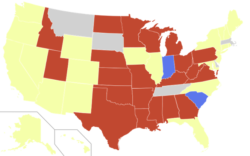Expectant families in the United States face bleak statistics. Our maternal mortality ratio (MMR), or number of deaths resulting from pregnancy-related causes during pregnancy or up to 42 days after, has increased every year since 1990. Only eight other countries have a rising MMR, including Afghanistan and Sudan. Our incidence of cesareans is double the World Health Organization’s recommended rate.
Our birth outcomes aren’t just bad relative to the rest of the world—they’re also alarmingly disparate within our own population. According to the Center for Disease Control, we lose three to four times as many black women to childbirth as we do white women, regardless of the education and income level of the mother. Georgia is no exception: We have the second highest maternal mortality rate in the nation. For all of our scientific and medical advances, we are failing people of all genders who give birth, and these outcomes are exacerbated for families of color and those below the poverty line. Why is this happening, and where’s a family to turn?
What Doulas Do
“I think a lot of people are shocked by how much time they spend alone in the hospital,” says Athens doula Kate Hodges. An anecdote about the first birth she attended reveals the collaborative support doctors, midwives and doulas can offer as a team.
“It was the mother’s fourth baby but her third pregnancy, because her prior birth had resulted in twins.” Hodges says. “She’d had a C-section with the twins, in addition to having a blood clotting disorder, which meant she couldn’t have an epidural,” an injection in the spine that numbs the lower body. Without an epidural, the mother’s “soothing options were anesthesia or a doula.”
Doulas are non-medical professionals who are present during change-of-life experiences. The most well-known type of doula is a labor doula, who provides ongoing support throughout labor and can remind the laboring parent of her choices. Labor doulas often meet with families before birth to help design a birth plan. Immediately before childbirth, a doula might offer support like poses such as squatting or offer massage to ease birth. Doulas are awake when everyone else in the labor room is sleeping. According to American College of Obstetricians and Gynecologists, “one of the most effective tools to improve labor and delivery outcomes is the continuous presence of support personnel, such as a doula.” A doula is “a supportive friend,” Hodges says. “It’s a person who’s been there, done that and can hold your hand along the way. An OBGYN or a midwife is going to take care of the medical aspects, but unfortunately, due to time constraints, often can’t spend as much time on the emotional aspects of birth as they would like.”
The “emotional aspects” have very real effects on the physical well-being of parent and child. Mothers who undergo epidurals or anesthesia, for example, report lower rates of babies latching onto the nipple for breastfeeding. Among myriad other benefits, ACOG reports that breastfeeding decreases the likelihood of Sudden Infant Death Syndrome and releases the hormone oxytocin in the parent, which contracts the uterus and encourages a return to regular size.
“Because it was a VBAC,” or vaginal birth after cesarean, “there were not very many providers the mother could go to.” Hodges says. VBACs, like so many birth choices, are shrouded in mystery. Not everyone is a good candidate for a VBAC, which has created a common misperception and adage: “once a cesarean, always a cesarean.” In other words, a mother that has had a C-section previously can only birth via C-section in the future. Both second cesareans and VBACs carry their own risks and benefits, and neither is objectively safer—it’s entirely based on the pre-existing health conditions of the mother.
Though VBACs are increasingly perceived as a viable birth option, lots of hospitals do not offer them. A study conducted by the nonprofit Childbirth Connection reveals that cesareans are convenient for doctors, who can arrange hectic hospital schedules more easily around cesarean appointments than unpredictable labor time. Cesareans are also more profitable, as NPR reported in 2013. Though life-saving for mothers that need them, cesareans also put mothers at risk for a hemorrhage, hysterectomy, infection and deep vein thrombosis. Families may not even learn about options like VBACs or risks of cesarean without the aid of a doula.
“It was beautiful to see the doctor treat her just like anyone else. She was doing the work on her own and just needed [fellow doula] Claire [Campbell] and I to hold the space down for her,” Hodges says. “When a patient has a doula, it imparts a level of confidence in the nurse, midwife and OBGYN that the mother is going to ask for what she needs. And when she does ask, they’re going to listen. They know if you went through enough energy and thought to hire a doula then you’ve put a lot of investment in this situation.”
Closing the Gap
Between 2000–2014, the most recent year statistics are available, eight black women died during labor in Clarke County, compared to zero white women, according to the U.S. Census Bureau statistics. This could be because, as ACOG says, black families are “substantially less likely to report equal speaking time (i.e., participatory decision making) compared with white patients.”
Insurance companies rarely cover doula support in Georgia, a disservice to families and providers alike. Watkinsville doula Emily Nolan’s clients have received reimbursement from nontraditional providers like Samaritan Ministries, which is a religious organization that matches coverage to need. Typically, though, providers only reimburse for doula work when forced to do so by law.
“I’ve always had a lack of understanding as to why the insurance companies aren’t supportive of” doula care, Hodges says. “The cost of hiring a doula is $700–$900 a pop. Compared to an $8,000 epidural and a $3,000 C-section, that’s a bargain. It’s true that there’s no guarantee that a doula will prevent those outcomes, but it significantly lowers the risk.”
Several doula practices offer sliding scale rates, and a few are generous and well-resourced enough to offer pro bono work on occasion. But doulas are not legally qualified to attend labor without a certified nurse midwife or doctor present, so they’re not the only cost.
The Athens Regional Midwifery Practice, in its 40th year, prioritizes closing gaps in care due to race and income. “Our waiting room is extremely diverse.” Athens Regional midwife Diana Calano says. “You might see a doctor/lawyer couple, UGA professors, inmates in handcuffs, a lot of refugees and folks from undocumented Latino communities. We have translators on staff.
“We almost never turn people away. We have an out-of-pocket package if folks can’t afford insurance or if they’re undocumented. We take Medicaid and Medicare.” Only a third of their clientele is privately insured, she says.
The total cost for all prenatal care is $1,550. For context, just one ultrasound normally runs up to $700, vaginal birth $11,000 and cesarean $14,000–$25,000. Self-Pay patients can opt to pay in installments throughout gestation and even the months following birth. Self-Pay patients can opt to pay in installments throughout gestation and even the months following birth.
ARMP isn’t the only midwife practice in Athens. Women’s Healthcare Associates specializes in obstetrics and gynecology and employs midwives. Their clients can birth at their practice, and midwives from WHA also attend births at St. Mary’s Hospital.
Athens Black Mothers Breastfeed, funded by a 2014 grant from the federal Women, Infants and Children health and nutrition program, helps “reduce racial disparities in breastfeeding rates through support, education and connection.” Postpartum care in a community setting can also reduce the incidence of MMR in the six weeks following birth.
Calano and Hodges both say that one of the primary barriers to safe birth outcomes for families under the poverty line is lack of insurance. The good news is that any Georgia woman without insurance qualifies for Pregnancy Medicaid.
“Sometimes there’s a delay because of socioeconomic resources [between] when a person gets pregnant and [when a person] shows up to get care.” Calano says. “There’s also this program in Georgia, P4HB.org. It’s basically free insurance for women’s health care. You have to be within a certain age group and hit a certain income level, and it’s not fully-fledged health insurance, but it covers a lot of the basics and more.” P4HB does not cover pregnancy, but it can help with associated costs and is an excellent compliment to Medicaid.
Calano’s best recommendation for a peaceful birthing experience is “a provider that’s on the same page as you, that’s going to work within your philosophy. Our goal is to help create space for the best experience possible for the family, and whatever that family might need. It’s about providing that space. A safe, comfortable, informed space.”
Sliding-scale or pro bono doulas:
Anna Salzman: [email protected]
By Your Leave Family Birthing Center
Resources for mothers:
Athens Black Mothers Breastfeed
Like what you just read? Support Flagpole by making a donation today. Every dollar you give helps fund our ongoing mission to provide Athens with quality, independent journalism.









